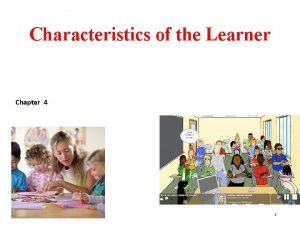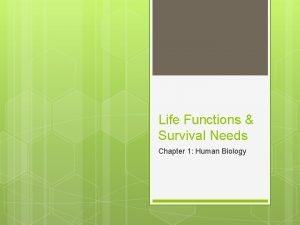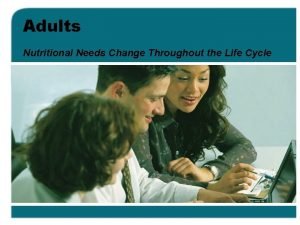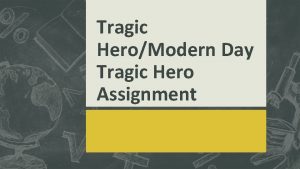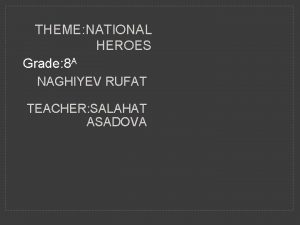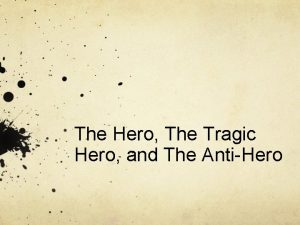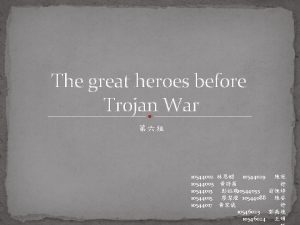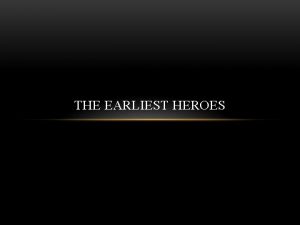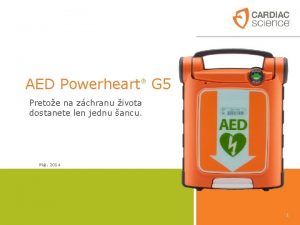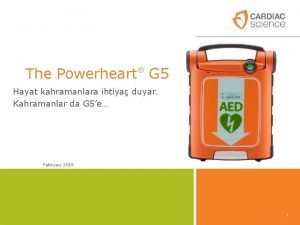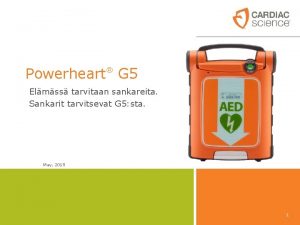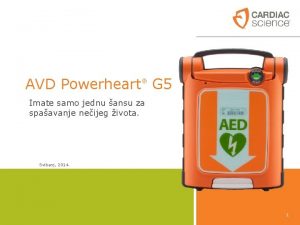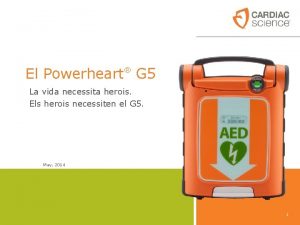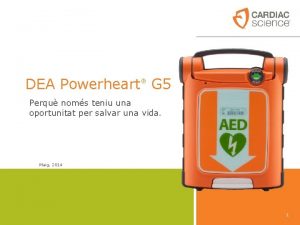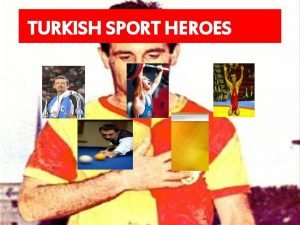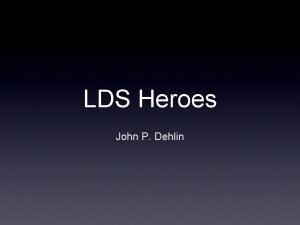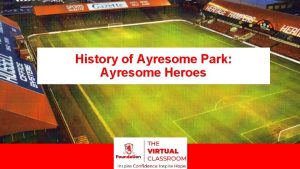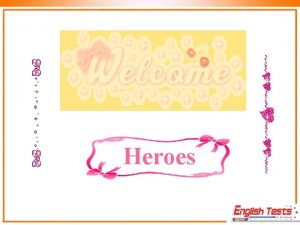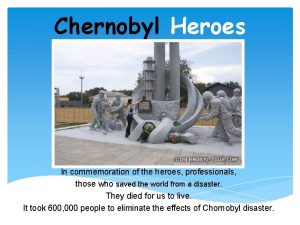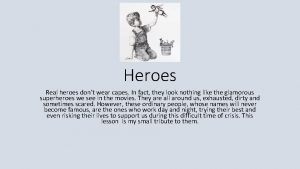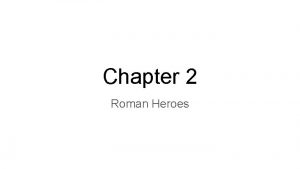The Powerheart G 5 Life needs heroes Heroes























































- Slides: 55

The Powerheart G 5 ® Life needs heroes. Heroes need the G 5. May, 2012 1

Agenda • Sudden Cardiac Arrest (SCA) • Defibrillation • The Powerheart G 5 AED 2

1 The Problem: Sudden Cardiac Arrest 3

SCA Deaths by Geography Sudden Cardiac Arrest: The Problem Japan Europe Sudden Cardiac Arrest (SCA) kills more than 400, 000 Europeans each year. North America China India SCA-related Deaths Per Year 4

Sudden Cardiac Arrest • The heart’s electrical impulses suddenly misfire. • Ventricular Fibrillation (VF) initiates most SCA heart rhythms. • In VF, the heart “quivers” uncontrollably and cannot pump blood. • SCA rarely converts spontaneously. It’s ultimately a defibrillator that restarts the heart. Source: AHA website, http: //www. heart. org/HEARTORG/Conditions/Arrhythmia/About. Arrhythmia/Ventricular. Fibrillation_UCM_324063_Article. jsp, accessed February 2012. 5

Sudden Cardiac Arrest • More than 50% of victims have no previous symptoms of coronary heart disease. 1 • Survival rates decrease by 10 -12% per minute. 2 • Each minute without oxygen diminishes the likelihood the victim will return to a “normal life. ” 1. Thom et al. “Heart Disease and Stroke Statistics – 2006 Update. ” Circulation, 2006: 113, e 85 -e 151. 2. Koster et al. “European Resuscitation Council Guidelines for Resuscitation 2010: Section 2, ” 2010, 1223. 6

Waiting for EMS is not enough • 94% of SCA victims die before reaching the hospital. 1 • The average call-to-shock time for a “typical community” is 11 minutes. 2 • Defibrillation within three minutes can increase survival rates to 75%. 3 1. Thom et al. “Heart Disease and Stroke Statistics – 2006 Update. ” Circulation, 2006: 113, e 85 -e 151. 2. Koster et al. “European Resuscitation Council Guidelines for Resuscitation 2010: Section 2”, 2010, 1278. 3. Nolan et al. “European Resuscitation Council Guidelines for Resuscitation 2010: Executive Summary”, 2010, 1223. 7

SCA Chain of Survival 8

Risk Factors • Coronary conditions • Respiratory Arrest • High cholesterol • Electrocution • High blood pressure • Drowning • Smoking • Stress • Obesity • Trauma • Diabetes Sources: Roger et al. “Heart Disease and Stroke Statistics— 2011 Update: A Report from the American Heart Association. ” Circulation, 2011: 123, e 19 -e 103. Nolan et al. “Executive Summary, ” ERC Guidelines for Resuscitation 2010, 1219. 9

Life-Threatening Arrhythmias • A normal heart rhythm has a distinct pattern • Fast or chaotic arrhythmias don’t allow the heart to effectively pump blood - • VF (Ventricular Fibrillation) VT (Pulseless Ventricular Tachycardia) Automated External Defibrillators (AEDs): designed to treat VF and VT Normal Heart Rhythm Ventricular Fibrillation (VF) Ventricular Tachycardia (VT) 10

AED Protocol Source: Nolan et al. “Executive Summary, ” ERC Guidelines for Resuscitation 2010, 1227. 11

2 Defibrillation 12

Defibrillation • Objective: restore an organised heart rhythm and spontaneous circulation • Delivers electrical current across the heart • Successful defibrillation “depolarizes” the heart’s cells • Depolarization allows the cells to “reorganise” • Defibrillation is the ONLY effective cure for VF! 13

3 The Solution: The Powerheart G 5 AED 14

Introducing the Powerheart G 5 AED The first AED that combines: • Rescue Ready® self-testing • Real-time CPR feedback • User-paced prompts • Fast shock times • Customised escalating energy For reliability, ease of use and advanced patient care. 15

Ready when needed Rugged design and rigorous self-testing ensure your AED will perform, even in harsh environments. • Rigorous daily, weekly, and monthly self-tests • High ingress protection rating (IP 55) for dust and water • Tested to military specifications* • Industry-leading warranties *MIL-STD-810 G 16

Easy to Use Real-time CPR feedback helps rescuers deliver CPR in line with Resuscitation Guidelines. • Proper compression rate and depth • Easy-to-follow voice and text prompts 17

Easy to Use So easy to use, even first-time rescuers can perform a successful rescue. • Rescue. Coach™ user-paced voice and text prompts guide users confidently through the rescue • Interchangeable pads simplify placement in a stressful situation 18

Easy to Use So easy to use, even first-time rescuers can perform a successful rescue. • Automatic shock delivery removes user hesitation to expedite patient therapy* • Dual-language options enable almost anyone to respond *Check for local availability. 19

Advanced patient care The Powerheart G 5 is the first AED that can deliver a higher energy shock in less than 10 seconds. * • Fast shock times give a victim the best chance of survival • The G 5 assesses the patient’s therapy needs and delivers customised shock at an appropriate energy level *Typical time-to-shock (post-CPR) 20

Advanced patient care Focus on the patient, not the process. • Adjust the prompts to fit the user’s skill level • Adapt CPR and shock protocols to your requirements and the latest Resuscitation Guidelines • Easily transfer and review rescue data 21

Unparalleled support and expertise • Global leader in defibrillation • More than 400, 000 AEDs deployed worldwide • Robust distribution network • Responsive local support North America Europe Asia Africa South America Australia • Locally-accessible training 22

Our work in Public Access Defibrillation First Response Municipal Transportation Corporate Schools Sport 23

4 Rescue Ready 24

Trusted Worldwide • More than 40 patents delivering unique, industry-leading features • Over 400, 000 Powerheart AEDs deployed worldwide • Available in nearly 100 countries North America Europe Asia Africa South America Australia • 27% US market share 25

Rugged design The Powerheart G 5 meets rigorous standards for performance • High ingress protection rating (IP 55) for water and dust • Tested to military standards 1 - Drop test (1. 22 M) - Shock - Vibration (sine/random) • Tested to IEC standards for electromagnetic interference 2 1. MIL-STD-810 G 2. IEC 60601 -2 -4 26

Rescue Ready technology • All AEDs have three main components - Battery – tested for presence and capacity Defibrillation pads – tested for presence and function Internal circuitry and software • Self-testing ensures the device is Rescue Ready - Daily: test and assess over 62 items Weekly: test and assess over 83 items, adds a partial charge test Monthly: test and assess over 88 items, adds a full energy charge test 27

Rescue Ready technology • If the self-test identifies any issues - Rescue Ready indicator turns red Audible alert every 30 seconds • The mechanical indicator operates without battery power • To identify the problem - Open the lid Refer to the text display or LED indicators 28

5 Ease of Use 29

Real-time CPR feedback • CPR rate and depth • Helps rescuers provide CPR consistent with Resuscitation Guidelines • AED automatically detects Device and provides every 7. 5 seconds (when needed) CPR feedback • Designed to improve CPR compliance for professional and non-professional rescuers 30

Automatic shock delivery • Patented feature eliminates the need to push a button • Expedite the rescue: just open lid, place pads • Eliminates rescuer hesitation to deliver defibrillation therapy 31

AEDs: Are they safe? • Electrical current “leakage” (between the patient and rescuer): no reported cases of harm to rescuers • Recent study: leakage is well within safety standards (<2, 500 microamperes)¹ 1. Michael Lloyd, et al, “Hands-On Defibrillation: An Analysis of Current Flow Through Rescuers In Contact With Patients During Biphasic External Defibrillation”, Circulation, 2008: 117(19), 2510 -2514. 32

Rescue. Coach voice prompts Rescue. Coach technology guides users confidently through the rescue process • User-paced voice and text prompts • Real-time CPR performance feedback 33

Non-polarized pads Defibrillation pads are designed with the non-professional rescuer in mind • Intuitive packaging: clear graphical directions and easypull tab • Non-polarized pads: interchangeable for rapid placement when critical seconds count • Minimum shelf life: 2 -years 34

Pediatric pads • Smaller size for easy placement on smaller victims • AED automatically detects pediatric pads and delivers reduced energy shock • AED Manager: easily customise pediatric protocols 35

Dual language • Convenient for bi-lingual environments • Swap languages with the touch of a button 36

6 Advanced patient care 37

Advanced patient care Provide the best patient care • Fast shock times • Variable escalating energy • Customised rescue protocols • Efficient rescue data transfer and review The first AED that delivers a higher energy shock post. CPR in less than 10 seconds (typically) to give a SCA victim the best chance of survival. 38

Variable escalating energy Only Powerheart AEDs provide a customised approach to energy delivery • Analyses each patient’s impedance to customise the energy level delivered • If more than one shock is necessary, the AED escalates the energy to an appropriate, higher level • Energy range: 95 joules to 354 joules (adult victim) Combining a higher energy shock (post CPR) and fast shock times to give a SCA victim the best chance of survival. 39

Customised shock delivery Advanced AED technology with the proprietary STAR® biphasic waveform • Customises defibrillation energy to deliver the most effective therapy • Treats cardiac arrest patients individually, based on three important characteristics: - Impedance Defibrillation threshold Cellular response 40

Impedance • Defined: the opposition to the flow of electrical current • Patient impedance - The primary barrier to effectively delivering defibrillation energy Each patient’s impedance is unique – due to body tissues (skin, fat, muscle, lungs), pad-to-skin contact and other factors • Higher patient impedance more resistance to defibrillation energy 41

Defibrillation threshold (DFT) • Defined: the minimum current required to defibrillate the heart • Each patient’s DFT is unique • Key factors - Patient anatomy Disease condition Metabolic state of the heart • Must exceed DFT to successfully defibrillate the heart 42

Cellular response • Within the heart, individual cardiac cells respond to the defibrillation shock • After defibrillation, the heart can retain excess charge from the shock • This can lead to immediate re-fibrillation (the heart returns to VF) 43

The Cellular Response Curve • Individual cardiac cells respond to the defibrillation shock • The heart’s cellular response is influenced by - Patient’s impedance Shape of the defibrillation waveform • This principle is characterized by “The Cellular Response Curve” 44

RHYTHMx® technology The RHYTHMx analysis algorithm separates the Powerheart G 5 from the competition • Only deliver a shock when needed • Non-committed shock: cancel a shock if the rhythm changes – even after the shock decision is made 45

Synchronised Shock Unique feature for treatment of VT and SVT arrhythmias • Synchronises on the R-wave • Treats other life-threatening arrhythmias - VT (ventricular tachycardia) - SVT (supra-ventricular tachycardia) • Avoids the vulnerable phase of the cardiac cycle (which may induce VF) 46

Minimum Asystole Threshold (MAT) • The ability of the AED to deliver a shock to fine VF - AHA recommendation is. 150 m. V Powerheart AEDs detect at. 08 m. V Competitive AEDs vary • Below this factor, arrhythmias are treated as asystole – and no shock is delivered • For AEDs with high MAT: fine VF may be diagnosed as asystole; no shock delivered 47

Flexible rescue settings • Customise your settings to match user skills and preferences - Independent settings for adult and pediatric - Voice prompts: basic, standard, advanced detail - CPR settings: Compression-Only, 30: 2, CPR First and more - Shock protocols: 10 energy settings; shock stacking • Easily update settings if Guidelines change in the future • AED Manager provides easy access 48

AED Manager – Configurations 49

AED Manager – Rescue Data 50

Data Recording • 90 minutes of AED & rescue data - AED Information ECG CPR Rescue prompt information • AED data: history logs and self-test information • Multiple rescue functionality 51

Data transfer • Easy communications - Transfer AED & rescue data Load software upgrades (if available) Customise rescue settings • Use your USB drive or cable - USB drive: automatic data transfer USB cable: one-button data transfer • USB data port located under the pad connector 52

Powerheart G 5 Accessories • Adult pads with CPR Device • Adult and Pediatric Pads • Carry Case or Carry Sleeve • Ready Kit • Rescue Backpack • Storage Solutions • AED Trainer 53

Powerheart AED G 5 54

3303 Monte Villa Parkway Bothell, WA 98021 425. 402. 2000 800. 426. 0337 Cardiac. Science. com © 2012, Cardiac Science Corporation. All rights reserved. MKT-25024 -02 r. B No part of this work may be reproduced in any form without written permission from Cardiac Science. 55
 Primary needs and secondary needs
Primary needs and secondary needs Satisfaction
Satisfaction Simple claustral complex
Simple claustral complex Strategic gender needs and practical gender needs
Strategic gender needs and practical gender needs Need analysis definition
Need analysis definition What are the criteria for prioritizing learning needs
What are the criteria for prioritizing learning needs Necessary life functions and survival needs
Necessary life functions and survival needs Nutritional needs throughout the life cycle
Nutritional needs throughout the life cycle Hát kết hợp bộ gõ cơ thể
Hát kết hợp bộ gõ cơ thể Frameset trong html5
Frameset trong html5 Bổ thể
Bổ thể Tỉ lệ cơ thể trẻ em
Tỉ lệ cơ thể trẻ em Chó sói
Chó sói Chụp tư thế worms-breton
Chụp tư thế worms-breton Chúa yêu trần thế
Chúa yêu trần thế Các môn thể thao bắt đầu bằng tiếng nhảy
Các môn thể thao bắt đầu bằng tiếng nhảy Thế nào là hệ số cao nhất
Thế nào là hệ số cao nhất Các châu lục và đại dương trên thế giới
Các châu lục và đại dương trên thế giới Công thức tính độ biến thiên đông lượng
Công thức tính độ biến thiên đông lượng Trời xanh đây là của chúng ta thể thơ
Trời xanh đây là của chúng ta thể thơ Cách giải mật thư tọa độ
Cách giải mật thư tọa độ 101012 bằng
101012 bằng độ dài liên kết
độ dài liên kết Các châu lục và đại dương trên thế giới
Các châu lục và đại dương trên thế giới Thơ thất ngôn tứ tuyệt đường luật
Thơ thất ngôn tứ tuyệt đường luật Quá trình desamine hóa có thể tạo ra
Quá trình desamine hóa có thể tạo ra Một số thể thơ truyền thống
Một số thể thơ truyền thống Cái miệng nó xinh thế
Cái miệng nó xinh thế Vẽ hình chiếu vuông góc của vật thể sau
Vẽ hình chiếu vuông góc của vật thể sau Biện pháp chống mỏi cơ
Biện pháp chống mỏi cơ đặc điểm cơ thể của người tối cổ
đặc điểm cơ thể của người tối cổ V cc
V cc Vẽ hình chiếu đứng bằng cạnh của vật thể
Vẽ hình chiếu đứng bằng cạnh của vật thể Phối cảnh
Phối cảnh Thẻ vin
Thẻ vin đại từ thay thế
đại từ thay thế điện thế nghỉ
điện thế nghỉ Tư thế ngồi viết
Tư thế ngồi viết Diễn thế sinh thái là
Diễn thế sinh thái là Dot
Dot Bảng số nguyên tố
Bảng số nguyên tố Tư thế ngồi viết
Tư thế ngồi viết Lời thề hippocrates
Lời thề hippocrates Thiếu nhi thế giới liên hoan
Thiếu nhi thế giới liên hoan ưu thế lai là gì
ưu thế lai là gì Sự nuôi và dạy con của hươu
Sự nuôi và dạy con của hươu Khi nào hổ mẹ dạy hổ con săn mồi
Khi nào hổ mẹ dạy hổ con săn mồi Sơ đồ cơ thể người
Sơ đồ cơ thể người Từ ngữ thể hiện lòng nhân hậu
Từ ngữ thể hiện lòng nhân hậu Thế nào là mạng điện lắp đặt kiểu nổi
Thế nào là mạng điện lắp đặt kiểu nổi List of unsung heroes in the bible
List of unsung heroes in the bible Modern day tragic hero
Modern day tragic hero National heroes of azerbaijan essay
National heroes of azerbaijan essay Anti hero traits
Anti hero traits The great heroes before the trojan war
The great heroes before the trojan war Prometheus and hera
Prometheus and hera





